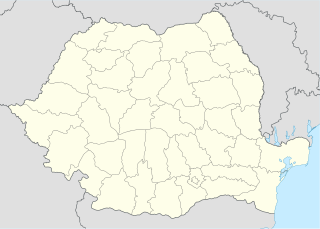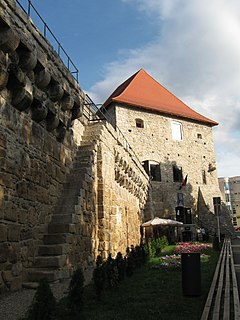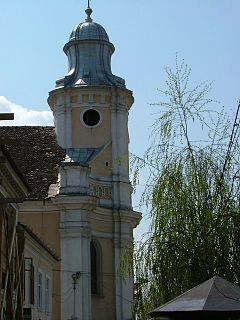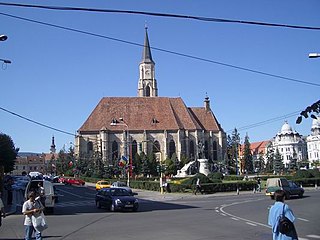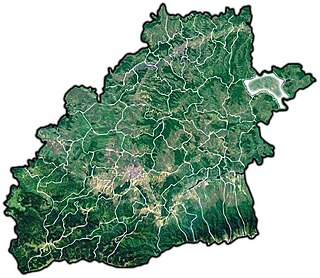This article needs additional citations for verification .(January 2017) (Learn how and when to remove this template message) |
The Tanners' Tower (Romanian : Turnul Tăbăcarilor, German : Gerberturm) in Sighişoara, belonging to Mureș County, Romania, was built around the 13th –14th centuries in the southeastern part of the city. It has a square plan, with a small, sloping roof in a single direction. This tower was supposed to guard and protect the courtyard of the Clock Tower.

Romanian is an Eastern Romance language spoken by approximately 24–26 million people as a native language, primarily in Romania and Moldova, and by another 4 million people as a second language. It is an official and national language of Romania and Moldova. In addition, it is also one of the official languages of the European Union.

German is a West Germanic language that is mainly spoken in Central Europe. It is the most widely spoken and official or co-official language in Germany, Austria, Switzerland, South Tyrol (Italy), the German-speaking Community of Belgium, and Liechtenstein. It is also one of the three official languages of Luxembourg and a co-official language in the Opole Voivodeship in Poland. The languages which are most similar to German are the other members of the West Germanic language branch: Afrikaans, Dutch, English, the Frisian languages, Low German/Low Saxon, Luxembourgish, and Yiddish. There are also strong similarities in vocabulary with Danish, Norwegian and Swedish, although those belong to the North Germanic group. German is the second most widely spoken Germanic language, after English.
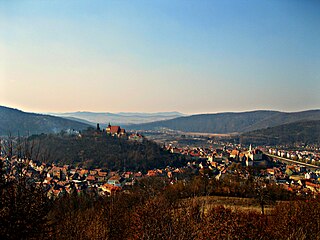
Sighișoara is a city on the Târnava Mare River in Mureș County, Romania. Located in the historic region of Transylvania, Sighișoara has a population of 28,102 according to the 2011 census. It is a popular tourist destination for its well-preserved walled old town, which is listed by UNESCO as a World Heritage Site.
Shape and position retracted behind the wall recommend it as one of the old towers, perhaps even the first one of the city. This tower with archaic aspect was not affected in any way by the fire in 1676. To defend the tower, tanneries used to have: a double arquebuse as well as a simple one, a musket, three hundred pounds of gunpowder and some cannonballs [1]

The arquebus, derived from the German Hakenbüchse, was a form of long gun that appeared in Europe during the 15th century. Although the term arquebus was applied to many different forms of firearms from the 15th to 17th centuries, it originally referred to "a hand-gun with a hook-like projection or lug on its under surface, useful for steadying it against battlements or other objects when firing." These "hook guns" were in their earliest forms defensive weapons mounted on German city walls in the early 1400s, but by the late 1400s had become handheld firearms. The development of the arquebus is somewhat tied to technology developed for the crossbow as without the stock from the crossbow, the arquebus would not have a stable platform to rest one's shoulder on. Priming pans also were placed on the arquebus. A matchlock mechanism was added around 1475 and it became the first firearm with a trigger. The heavy arquebus, known as the musket, was developed to better penetrate plate armor and appeared in Europe around 1521. A standardized arquebus, the caliver, was introduced in the latter half of the 16th century. The name "caliver" is derived from the English corruption of calibre, which is a reference to the gun's standardized bore. The caliver allowed troops to load bullets faster since they fit their guns more easily, whereas before soldiers often had to modify their bullets into suitable fits, or were even forced to make their own prior to battle. The smoothbore matchlock arquebus is considered the forerunner to the rifle and other long gun firearms. Heavy arquebuses mounted on wagons were called arquebus à croc. These carried a lead ball of about 3.5 ounces (100 g).

A musket is a muzzle-loaded long gun that appeared as a smoothbore weapon in early 16th-century Europe, at first as a heavier variant of the arquebus, capable of penetrating heavy armor. By the mid-16th century, this type of musket went out of use as heavy armor declined, but as the matchlock became standard, the term musket continued as the name given for any long gun with a flintlock, and then its successors, all the way through the mid-1800s. This style of musket was retired in the 19th century when rifled muskets became common as a result of cartridged breech-loading firearms introduced by Casimir Lefaucheux in 1835, the invention of the Minié ball by Claude-Étienne Minié in 1849, and the first reliable repeating rifle produced by Volcanic Repeating Arms in 1854. By the time that repeating rifles became common, they were known as simply "rifles", ending the era of the musket.
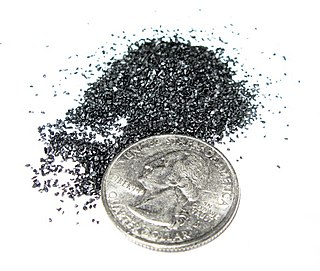
Gunpowder, also known as black powder to distinguish it from modern smokeless powder, is the earliest known chemical explosive. It consists of a mixture of sulfur (S), charcoal (C), and potassium nitrate (saltpeter, KNO3). The sulfur and charcoal act as fuels while the saltpeter is an oxidizer. Because of its incendiary properties and the amount of heat and gas volume that it generates, gunpowder has been widely used as a propellant in firearms, artillery, rockets, and fireworks, and as a blasting powder in quarrying, mining, and road building.
Coordinates: 46°13′07″N24°47′33″E / 46.21860°N 24.79256°E

A geographic coordinate system is a coordinate system that enables every location on Earth to be specified by a set of numbers, letters or symbols. The coordinates are often chosen such that one of the numbers represents a vertical position and two or three of the numbers represent a horizontal position; alternatively, a geographic position may be expressed in a combined three-dimensional Cartesian vector. A common choice of coordinates is latitude, longitude and elevation. To specify a location on a plane requires a map projection.


